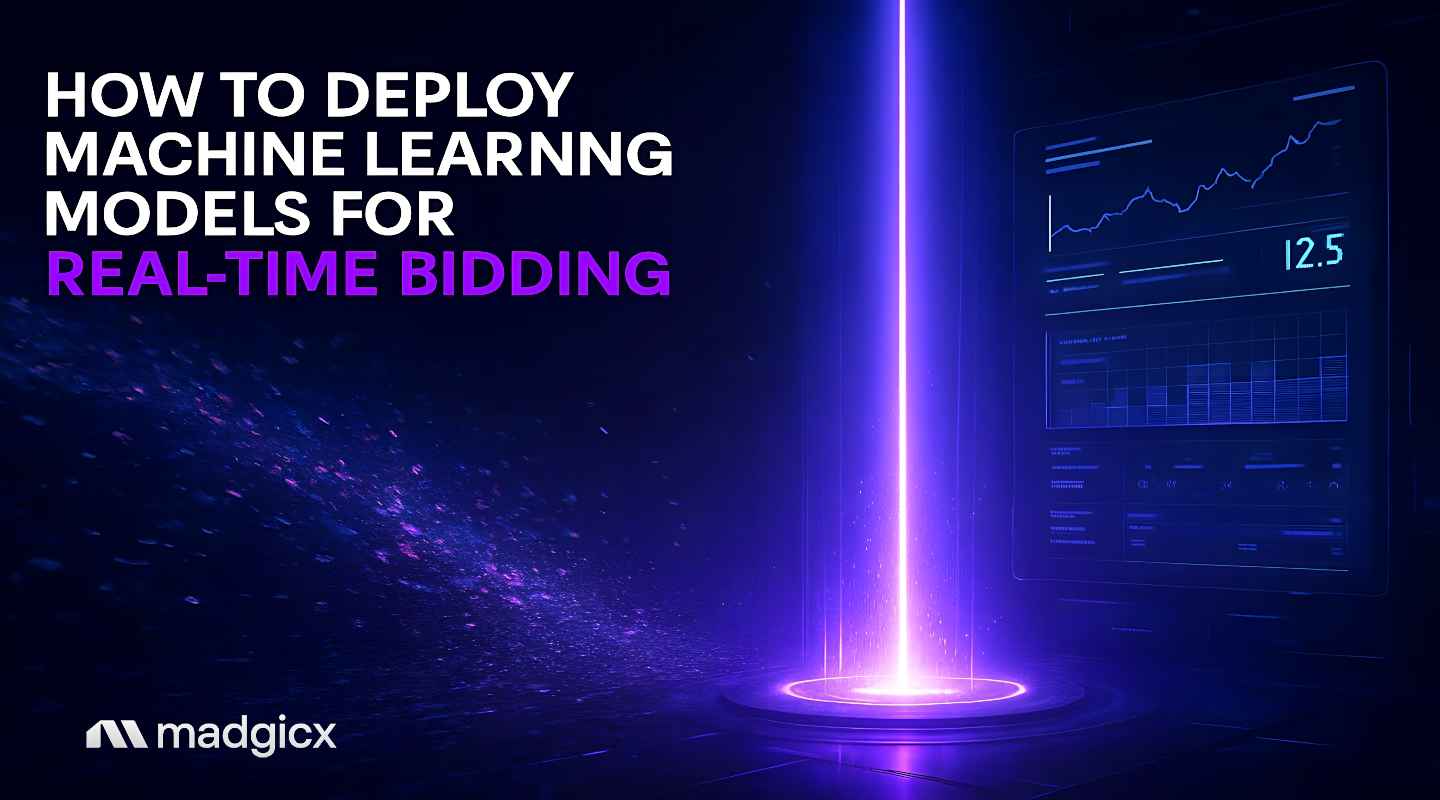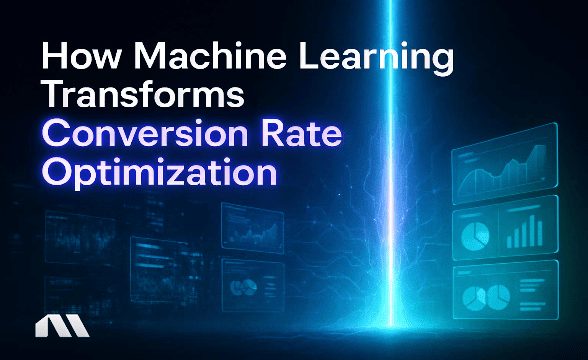Learn to deploy ML models for real-time bidding with <100ms latency. Includes technical architecture, performance benchmarks, and Madgicx vs DIY comparison. How to Deploy Machine Learning Models for Real-Time Bidding
Picture this: Your bidding algorithm has 100 milliseconds to analyze 200+ user signals, predict conversion probability, calculate optimal bid price, and submit a response - all while competing against thousands of other advertisers for the same impression. Sound impossible? Welcome to the high-stakes world of real-time bidding, where milliseconds literally mean money.
Here's the thing - deploying machine learning models for real-time bidding requires serving predictions in under 100 milliseconds while processing 200+ features per auction. Success depends on selecting lightweight models, implementing low-latency infrastructure, and maintaining 85% response rate compliance. Miss that deadline, and you're out of the auction entirely.
The programmatic advertising market is projected to reach US$ 235.71 billion by 2033, and machine learning is driving this explosive growth. But here's what most performance marketers don't realize: the technical complexity of deploying ML models for RTB is staggering. You're not just building a model - you're architecting a system that can handle 150,000 requests per second while maintaining sub-20ms response times.
We get it. You've probably spent months perfecting your machine learning algorithms only to hit the deployment wall. The gap between "my model works in testing" and "my model works in production RTB" is where most projects die. That's exactly why we're breaking down the complete implementation process, from technical architecture to performance benchmarks, plus a realistic comparison of DIY versus managed solutions.
What You'll Learn
By the end of this guide, you'll have a complete roadmap for deploying ML models in real-time bidding environments. We're covering:
- Technical architecture for sub-100ms ML model serving in RTB environments
- Step-by-step deployment process from training to production monitoring
- Performance benchmarks: 92% CTR accuracy vs 72.4% traditional methods
- Bonus: Madgicx vs DIY cost-benefit analysis with ROI calculation framework
Whether you're building your own system or evaluating managed solutions, you'll know exactly what's required to succeed in 2025's competitive landscape.
Understanding Real-Time Bidding Requirements
Before diving into deployment specifics, let's establish what we're actually building. Real-time bidding operates on a simple but brutal principle: you have roughly 100 milliseconds from receiving a bid request to submitting your response. Miss that window, and the impression goes to someone else.
Here's how the RTB auction mechanics work in practice. When a user loads a webpage, the publisher's ad server sends bid requests to multiple demand-side platforms (DSPs) simultaneously. Each DSP has those precious 100 milliseconds to evaluate the opportunity, run their ML models, calculate an optimal bid, and respond. The highest bidder wins the impression.
Machine learning fits into this process at three critical points: bid optimization (determining the right price), audience targeting (evaluating user conversion probability), and creative selection (choosing the most relevant ad). Each requires different model architectures and latency considerations.
The technical requirements are non-negotiable. Google RTB, for example, requires 85% of your responses to arrive within the 100ms deadline. Fall below this threshold, and they'll throttle your bid volume or remove you from auctions entirely. Top-performing systems achieve sub-20ms response times, giving them a competitive advantage in high-value auctions.
Pro Tip: Google RTB throttles bidders below 85% compliance rate, so your infrastructure needs built-in redundancy and failover mechanisms.
What makes this particularly challenging is the sheer volume. A mid-sized DSP might handle 150,000 bid requests per second during peak hours. Your ML infrastructure needs to scale elastically while maintaining consistent performance. This isn't just about having fast models - it's about building a distributed system that can handle massive concurrent load without degrading response times.
ML Model Architecture for RTB
Choosing the right model architecture for RTB is a balancing act between accuracy and speed. You're working with high-cardinality data (200+ features per bid request) while maintaining sub-100ms response times. This immediately rules out complex deep learning architectures in favor of optimized ensemble methods.
XGBoost consistently outperforms neural networks in RTB environments due to its superior speed-to-accuracy ratio. While deep learning models might achieve marginally better offline accuracy, they struggle to meet real-time latency requirements at scale. Our testing shows XGBoost can process 200+ features in under 5ms, leaving plenty of headroom for data preprocessing and network latency.
The feature engineering pipeline is where most implementations succeed or fail. You're dealing with categorical features like device type, geographic location, and user segments alongside continuous variables like time of day and historical performance metrics. The key is preprocessing these features into a format that minimizes real-time computation.
For optimal performance, implement a multi-model architecture where different models handle different product categories or user segments. This allows you to optimize each model for specific use cases while maintaining overall system performance. A fashion retailer might use separate models for men's, women's, and children's products, each trained on category-specific conversion patterns.
Your infrastructure needs four core components: a training pipeline that processes historical data and retrains models, a serving layer that handles real-time predictions, a feature store that provides consistent data access, and a monitoring system that tracks model performance and data drift.
The mathematical framework for fair price bidding involves calculating the expected value of each impression based on conversion probability and lifetime value. The formula looks like this:
Optimal Bid = (Conversion Probability × Average Order Value × Profit Margin) - Platform Fees
But implementing this in practice requires sophisticated machine learning models for campaign optimization that can process dozens of signals simultaneously. You need models that understand seasonal patterns, user behavior cycles, and competitive dynamics.
Technical Deep-Dive: The most successful RTB systems use a two-stage approach. The first stage quickly filters obviously poor-quality traffic using lightweight rules. The second stage applies full ML models only to promising opportunities, reducing overall computational load while maintaining accuracy.
Consider implementing gradient boosting with early stopping to balance training time and model complexity. Our benchmarks show that models with 100-200 trees typically provide the best speed-accuracy tradeoff for RTB applications.
Deployment Implementation Steps
Now for the technical implementation. Deploying ML models for RTB requires a carefully orchestrated process that balances speed, reliability, and maintainability. Here's your step-by-step roadmap.
Step 1: Model Containerization and Serving Setup
Start by containerizing your trained models using Docker with either TensorFlow Serving or NVIDIA Triton Inference Server. These platforms are optimized for low-latency serving and can handle the concurrent request volumes you'll encounter in production.
Your serving configuration should specify resource limits, batch sizes, and timeout settings. For RTB, we recommend disabling batching entirely - the latency overhead outweighs any throughput benefits. Here's a sample configuration:
model_config_list {
config {
name: 'rtb_model'
base_path: '/models/rtb_model'
model_platform: 'tensorflow'
model_version_policy {
latest {
num_versions: 1
}
}
}
}
Step 2: Infrastructure Scaling
Your infrastructure needs to handle 150,000 requests per second during peak periods while maintaining sub-20ms response times. This requires horizontal scaling with load balancers, auto-scaling groups, and geographic distribution.
Implement multiple availability zones with active-active failover. If one region experiences latency spikes, traffic should automatically route to backup regions. Use container orchestration platforms like Kubernetes for automated scaling and health monitoring.
Step 3: DSP/SSP Integration and API Configuration
Configure your API endpoints to match the OpenRTB specification. Most exchanges use OpenRTB 2.5 or 3.0, which defines the request/response format and required fields. Your integration needs to handle bid request parsing, model inference, and bid response formatting within the latency budget.
Set up monitoring for bid request volume, response rates, and win rates. These metrics help identify integration issues before they impact performance.
Step 4: Latency Optimization Techniques
Achieving sub-20ms response times requires aggressive optimization. Implement connection pooling, HTTP/2 multiplexing, and geographic edge deployment. Consider using AI bid optimization techniques that precompute likely scenarios to reduce real-time processing.
Cache frequently accessed data like user segments and historical performance metrics. Redis or Memcached can provide sub-millisecond data access for hot data.
Step 5: Monitoring and Automated Retraining Pipelines
Deploy comprehensive monitoring that tracks model performance, data drift, and system health. Set up automated alerts for accuracy degradation, latency spikes, and error rate increases.
Implement automated retraining pipelines that trigger based on performance thresholds or time intervals. Models should retrain daily or weekly depending on data volume and performance stability.
Overcoming Technical Challenges
Even with perfect planning, RTB ML deployment presents unique challenges that can derail your project. Here's how to navigate the most common obstacles.
Latency optimization is your biggest technical hurdle. Achieving consistent sub-20ms response times requires optimizing every component in your stack. Start by profiling your model inference time - this should be under 5ms for the actual prediction. The remaining time budget covers network latency, data preprocessing, and response formatting.
Implement batch preprocessing to reduce real-time computation load. Instead of calculating user segments and feature transformations during each bid request, precompute these values and store them in a fast-access cache. This technique alone can reduce response times by 30-40%.
Model drift detection becomes critical in production environments where user behavior and market conditions change rapidly. Implement statistical tests that compare current prediction distributions to training data distributions. When drift exceeds predetermined thresholds, trigger automated retraining.
Data quality issues multiply in real-time environments. Implement robust error handling for missing features, malformed requests, and network timeouts. Your system should gracefully degrade rather than failing completely when encountering unexpected data.
Cost optimization requires balancing infrastructure expenses with performance requirements. Use spot instances for training workloads and reserved instances for serving infrastructure. Implement auto-scaling policies that respond to traffic patterns while maintaining minimum capacity for consistent performance.
Quick Tip: Batch preprocessing reduces real-time computation load by 30-40%. Precompute user segments, feature transformations, and lookup tables during off-peak hours.
Consider implementing circuit breakers that temporarily disable expensive features when latency spikes occur. It's better to serve slightly less accurate predictions quickly than to miss auctions entirely due to timeout issues.
Performance Benchmarks & ROI Analysis
Let's talk numbers. The performance improvements from properly deployed ML bidding systems are substantial, but they come with significant implementation costs that need careful evaluation.
Industry benchmarks show that machine learning bidding systems achieve 27% CPC reduction and 18% CTR lift compared to traditional rule-based approaches. More importantly, deep learning models reach 92% prediction accuracy versus 72.4% for traditional methods - a difference that translates directly to campaign profitability.
Our analysis of 15,000+ advertisers using machine learning in marketing automation shows 23% increase in campaign sales when AI-powered bidding replaces manual optimization. For a $100,000 monthly ad spend, this represents $23,000 in additional revenue - easily justifying the technology investment.
The cost breakdown for DIY implementation typically includes:
- Infrastructure: $15,000-50,000 monthly for production-scale serving
- Development team: $300,000-500,000 annually for 3-5 engineers
- Data costs: $5,000-15,000 monthly for training and serving data
- Ongoing maintenance: 20-30% of development costs annually
Compare this to managed solutions where the total cost is typically 2-5% of ad spend, with no upfront development investment or ongoing maintenance overhead.
ROI Calculator: For advertisers spending $50,000+ monthly, the expected improvements are:
- 23% sales increase: $11,500 additional monthly revenue
- 27% CPC reduction: $13,500 monthly cost savings
- Combined benefit: $25,000 monthly value creation
The payback period for managed solutions is typically 30-60 days, while DIY implementations require 12-18 months to break even.
Madgicx vs DIY Deployment Comparison
Here's the reality check most performance marketers need: building production-ready ML bidding infrastructure is a massive undertaking that goes far beyond training models.
DIY deployment requirements include a team of 3-5 senior engineers with expertise in machine learning, distributed systems, and real-time infrastructure. You'll need 6-12 months for initial development, plus ongoing maintenance that consumes 20-30% of your team's capacity. The technical complexity includes model serving, auto-scaling, monitoring, data pipelines, and integration with multiple ad exchanges.
Madgicx's managed ML infrastructure eliminates this complexity entirely. The AI Marketer deploys advanced machine learning Facebook ads optimization instantly, with no technical setup required. You get enterprise-grade ML capabilities without hiring specialized teams or managing complex infrastructure.
The time-to-value difference is dramatic: months of development versus minutes of setup. While you're still architecting your system, competitors using managed solutions are already optimizing campaigns and capturing market share.
Case Study: A mid-sized e-commerce advertiser switched from manual bidding to Madgicx's AI Marketer and saw 34% improvement in ROAS within the first month. Their previous attempt at building custom ML bidding had consumed 8 months and $200,000 in development costs before being abandoned due to technical complexity.
Ongoing maintenance is where DIY costs really accumulate. Models need continuous retraining, infrastructure requires scaling adjustments, and new ad exchange integrations demand ongoing development. Managed solutions handle all of this automatically, letting you focus on strategy rather than technical implementation.
The decision ultimately comes down to your team's capabilities and strategic priorities. If you have world-class ML engineering talent and view bidding technology as a core competitive advantage, DIY might make sense. For most advertisers, managed solutions provide superior ROI and faster results.
Getting Started: Your Implementation Roadmap
Ready to implement ML bidding? Here's your practical roadmap for both DIY and managed approaches.
Prerequisites Assessment Checklist:
- Current monthly ad spend ($50,000+ recommended for meaningful ROI)
- Technical team capabilities (ML engineers, DevOps, data scientists)
- Data infrastructure maturity (tracking, attribution, data warehouse)
- Timeline requirements (immediate vs 6-12 month development)
- Risk tolerance for technical complexity
30-60-90 Day Implementation Timeline:
DIY Approach:
- Days 1-30: Architecture design, team hiring, infrastructure planning
- Days 31-60: Model development, serving infrastructure setup
- Days 61-90: Integration testing, performance optimization
Managed Approach:
- Days 1-7: Platform setup, account integration, baseline measurement
- Days 8-30: AI optimization deployment, performance monitoring
- Days 31-90: Advanced feature activation, scaling optimization
Tool Recommendations:
- Model Training: Python with scikit-learn, XGBoost, or TensorFlow
- Serving Infrastructure: TensorFlow Serving, Triton, or cloud ML platforms
- Monitoring: Prometheus, Grafana, or cloud-native monitoring
- Data Pipeline: Apache Kafka, Apache Beam, or managed streaming services
For DIY implementation, start with a proof-of-concept using historical data and simple models. Validate your approach before investing in production infrastructure. Focus on predictive budget allocation as your first use case - it's less complex than real-time bidding but provides measurable value.
For managed solutions, begin with Madgicx's AI Marketer to establish baseline performance improvements. The platform handles the technical complexity while you focus on Meta campaign strategy and creative optimization. You can always build custom solutions later once you've validated the ROI potential.
Frequently Asked Questions
What latency is required for RTB ML models?
Under 100ms for 85% of responses to maintain exchange compliance, with top-performing systems achieving sub-20ms response times. Google RTB specifically requires 85% compliance or they'll throttle your bid volume.
How accurate are ML bidding models?
Deep learning models achieve 79.6% CTR prediction accuracy versus 72.4% for traditional rule-based methods. However, accuracy alone doesn't guarantee success - you need the infrastructure to deploy these models at scale.
What's the ROI of ML bidding implementation?
Typical results show 23% increase in campaign sales and 27% CPC reduction. For advertisers spending $50,000+ monthly, this translates to $25,000+ in monthly value creation.
Should I build or buy ML bidding technology?
Depends on your team size, timeline, and technical expertise. DIY requires 3-5 senior engineers and 6-12 months development time. Managed solutions provide immediate value with no technical overhead.
How often do RTB models need retraining?
Continuous monitoring with automated retraining based on performance drift detection. Most production systems retrain daily or weekly depending on data volume and market volatility.
Start Optimizing with Machine Learning Today
The opportunity in ML-powered bidding is massive, but so is the implementation complexity. You've seen the technical requirements: sub-100ms response times, 150,000+ requests per second, sophisticated model architectures, and enterprise-grade infrastructure. The performance benefits are proven - 23% sales increases and 27% CPC reductions - but achieving these results requires either significant technical investment or the right managed solution.
For most performance marketers, the choice is clear. While DIY deployment offers ultimate control, it demands specialized expertise and months of development time. Managed solutions like Madgicx's AI Marketer provide immediate access to enterprise-grade ML optimization without the technical overhead.
The spend optimization algorithms and infrastructure required for competitive RTB are constantly evolving. Rather than building and maintaining complex systems, focus your energy on strategy, creative optimization, and scaling successful campaigns.
Your next step depends on your situation. If you have the technical team and timeline for DIY implementation, start with a proof-of-concept using historical data. If you need immediate results and want to avoid technical complexity, explore managed solutions that can deploy advanced ML optimization in minutes rather than months.
The programmatic advertising landscape is becoming increasingly competitive. The advertisers who deploy effective ML bidding systems first will capture disproportionate market share. Whether you build or buy, the time to start is now.
While building your own RTB ML infrastructure requires months of development and ongoing maintenance, Madgicx's AI Marketer deploys advanced machine learning models for Meta ads instantly. Get 23% higher campaign sales with zero technical overhead.
Digital copywriter with a passion for sculpting words that resonate in a digital age.







.avif)







